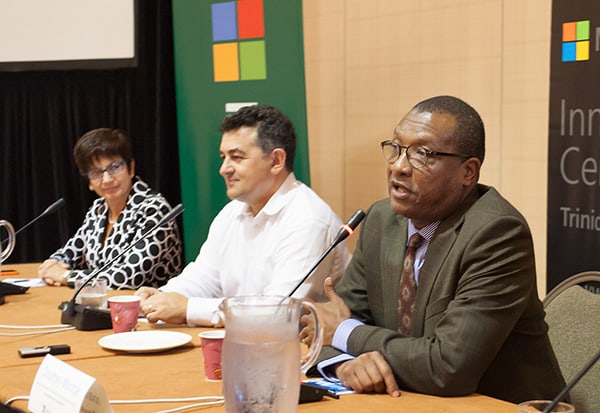
Above: Frances Correia, Country Manager, Microsoft Trinidad & Tobago, Eastern & Southern Caribbean; Marc Reguera, Finance Director in the Enterprise Partner Group, Microsoft and Courtney Munroe, Group VP of Worldwide Telecommunications Research, IDC face the press at the M4 conference. Photo by Mark Lyndersay.
BitDepth#1012 for October 27, 2015
Courtney Munroe, the featured keynote speaker at last Thursday’s Microsoft M4 conference at the Hyatt has a lot to say about global ICT trends, but one of his stand out cautions to information technology professionals that morning was the anticipated growth in what he described as “shadow IT.”
Munroe, VP for Telecom Research for the International Data Corporation, a noted think-tank of technology analysts and researchers is Guyanese but now operates out of Miami.
IDC sees the immediate future of technology development as happening under four main pillars, cloud technology, mobility, social and big data.
Much of what’s to come in that space is being seeded right now in emerging technologies. Cognitive systems and automation, the growth and ubiquity of cloud based solutions and the growth of industry and personal robotics aren’t in their nascent stages anymore, but they are still to become ubiquitous.
IDC expects, for instance that more than 30 billion sensors will be active in the world over the next few years, electronic feelers that will be increasingly activated and connected by the Internet of Things.
But shadow IT is with us right now and represents both challenges and opportunities as increasingly savvy users make use of commonly available technologies in their workflow before getting the formal approval of IT departments.
Ineke Geesnik, Windows Business Group Lead at Microsoft LATAM agreed with Munroe’s observations about “the consumerisation of technology.”
“What people need on the business side is becoming similar to what companies need and millenials coming into companies are bringing their own challenges,” Geesnik explained.
Nowhere has this been clearer than in the world of telecommunications, where carriers are being hurt by consumers who make use of chat and communications services built into social media channels.
The response to that, Munroe suggests, is the move to hybrid IT, which will find companies and businesses developing custom solutions that specifically address internal as well as customer needs using open source tools instead of trying to make systems fit into off-the shelf systems.
IDC sees the growth of traditional IT solutions declining relative to these next generation solutions in the future.
IDC has found that 60 per cent of online transactions take place via social media apps, marking a crucial convergence of marketing and services.
The company projects that more than 50 per cent of ecommerce transactions will take place on mobile devices by 2020 and by then, most enterprise mobile apps will be optimised for phone and tablet use, not PCs and WiFi hotspots will drive half of all Internet access.
In the Caribbean, Trinidad and Tobago tops the charts for mobile penetration at 158 per cent, followed by Barbados at 103 per cent and Guyana at 99 per cent.
By comparison, Barbados leads in fixed broadband penetration at 27 per cent, with T&T at 20 per cent and Puerto Rico at 17 per cent.
Globally, infrastructure is shifting to digital fibre to support a industry shift from being hardware-centric to an environment based on software.
At a press conference after his presentation, Courtney Munroe acknowledged the need for governments to drive such infrastructure needs.
“Oh, absolutely, Government has a role to play in driving investment in the technologies,” he said.
“Countries which have done so are strong, particularly in Asia, where government have either directly invested in technology or provided a framework for technology to flourish.”
“Trinidad and Tobago is very advanced relative to other regional and Latin American countries, the groundwork is there for Trinidad to be one of the leaders; the infrastructure base is definitely there.”
Munroe acknowledged Digicel as one company that’s provided a model for aggressive ownership of its market space, as proven by “The amount of work they have put in and the number of countries they have entered, pushing rivals out of some of those markets.”
The next wave of development will be in building on the existing infrastructure and increasingly accessible development tools.
Marc Reguera, Director of Finance, Worldwide Microsoft observed that: “In the last few years, the cloud has offered an incredible environment for development and innovation, but IT departments have a role in ensuring that the data is accessible and secure.”
“At Microsoft, our watchwords are discipline at the core, flexibility at the edge. You need the balance to drive innovation.”


